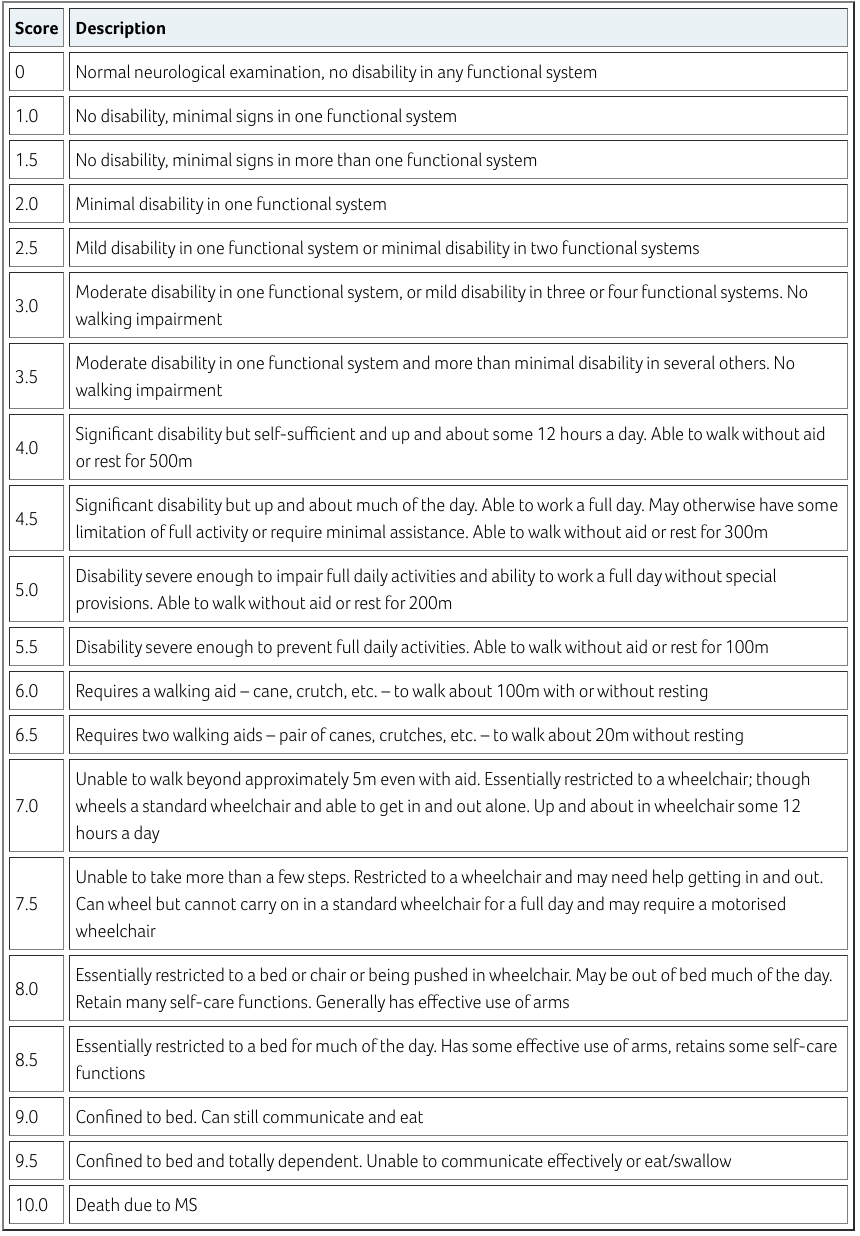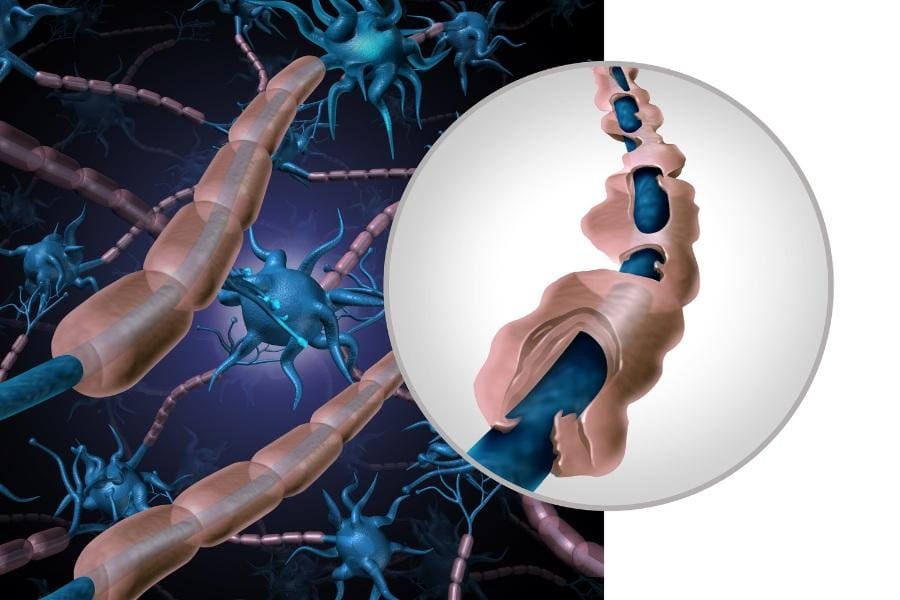Living with aggressive onset multiple sclerosis can feel like your world has been turned upside down overnight.
This severe form of MS moves quickly, causing symptoms and challenges to appear much faster than anyone is prepared for.
When someone receives this diagnosis, they often face intense symptoms right from the start – symptoms that can profoundly reshape their daily routines and activities they once took for granted.
What makes aggressive MS different from other forms of multiple sclerosis is its unrelenting nature. While typical MS often develops gradually, aggressive MS doesn’t wait.
It can be particularly frustrating because the usual treatments might not work as well as expected, and physical changes can happen more rapidly. Understanding these unique characteristics is crucial because it helps doctors and patients work together quickly to find the most effective path forward.
There’s no sugarcoating it – facing aggressive MS can feel overwhelming, like climbing a mountain that keeps getting steeper. It’s a very active disease. But here’s what’s important to know: you’re not alone on this journey.
With the right support system, medical team, and management strategies, many people find ways to maintain their quality of life and independence.
Key Takeaways
- Aggressive onset MS leads to rapid progression and increased disability.
- Early diagnosis is critical for effective management and treatment strategies.
- Understanding the characteristics of aggressive MS can improve quality of life for patients.
Understanding Multiple Sclerosis
IN THIS ARTICLE

Multiple sclerosis (MS) is a chronic disease that affects the central nervous system.
It can take various forms, influencing how it manifests in individuals. Understanding these classifications and recognizing the symptoms is essential for diagnosis and management.
Classifications of MS
There are several classifications of multiple sclerosis, each with unique characteristics. The most common types include:
- Relapsing-Remitting MS (RRMS): This is the most prevalent form. It involves periods of symptom flare-ups followed by recovery. Symptoms often improve or disappear during remission.
- Secondary Progressive MS (SPMS): This form typically follows RRMS. It involves a gradual worsening of disability, with or without flare-ups. The transition can vary from person to person.
- Primary Progressive MS (PPMS): This type is marked by a steady decline in function from the outset, without distinct relapses or remissions. Symptoms increase gradually over time.
- Progressive MS: This is a broader category that includes both primary and secondary progressive forms.
Understanding these types helps in the management and treatment of MS, as each classification may require different approaches.
What is aggressive onset multiple sclerosis?
A disease with a rapid progressive course, leading to significant disability in multiple neurologic systems or death in a relatively short time after disease onset
Symptoms and Diagnosis
Symptoms of multiple sclerosis can vary widely.
Common symptoms include
- Fatigue
- Vision problems
- Balance issues
- Some experience tingling in the limbs
Diagnosis typically involves a combination of neurological exams and imaging tests, such as MRIs. The doctor may look for lesions in the brain and spinal cord, which indicate damage from MS.
To reach a diagnosis, healthcare providers assess the clinical course of the disease. They may use criteria from the McDonald Guidelines, which help identify the type of MS based on the patient’s symptoms and medical history.
Early diagnosis of the active disease can lead to better outcomes through proactive management of the condition.
Characteristics of Aggressive Onset MS
Aggressive onset multiple sclerosis is a severe form that features a rapid progression of symptoms and significant long-term impacts.
Patients often experience a combination of severe inflammatory responses and neurological disability that can lead to irreversible effects, such as permanent disability.
Let’s discuss some of the clinical characteristics.
Clinical Phenotype
Aggressive Multiple Sclerosis (AMS) frequently presents with a clinical phenotype that diverges from typical MS cases.
Patients often show early symptoms such:
- Motor impairment
- Visual disturbances
- Sensory loss
In particular, those with Highly Active MS may exhibit a rapid increase in disability, and in some cases, a need for immediate treatment.
The Expanded Disability Status Scale (EDSS) is often used to assess the severity. An EDSS score of ≥ 6.0 within five years is a common marker for aggressive onset. Neurological symptoms can escalate quickly, making it essential for healthcare providers to thoroughly monitor changes in the patient’s condition.
Here is the Expanded Disability Status Scale:

Neurodegeneration and Disability
Neurodegeneration in aggressive MS occurs at a more rapid rate compared to more mild forms of the disease. Inflammation plays a crucial role, often leading to extensive damage to the central nervous system. T
his can result in significant, long-term disability.
Patients may experience irreversible disability early on, impacting their ability to perform daily activities. Studies indicate that individuals can face malignant MS, a severe subtype where symptoms worsen rapidly and lead to debilitating conditions.
As the disease progresses and severe attacks become more prevalent, the likelihood of requiring long-term care increases, emphasizing the need for timely and effective treatment strategies.
Diagnostic Criteria and Tools

The diagnosis of aggressive onset multiple sclerosis (MS) involves specific criteria and advanced tools.
Key elements include MRI data and the use of biomarkers and assessments that help identify the severity and progression of the disease.
The best case scenario is these effective therapies and assessments occur at the disease onset.
MRI Data
MRI scans are critical in diagnosing aggressive onset MS. They reveal the presence of T2 MRI lesions, which are indicative of brain and spinal cord damage. A significant finding involves Gd+ lesions, enhancing lesions that suggest active inflammation.
The Expanded Disability Status Scale (EDSS) is often used alongside MRI data to assess a patient’s level of disability. Higher EDSS scores indicate more severe disability, which correlates with increased lesion load seen on MRI.
Healthcare professionals look for a specific number and location of lesions to make a diagnosis. A greater number of lesions or particular patterns may signal a more aggressive form of the disease.
Biomarkers and Assessments
Molecular biomarkers play a vital role in identifying aggressive MS. These can include specific proteins or genetic markers found in cerebrospinal fluid or blood tests.
Imaging biomarkers from advanced MRI techniques also aid in the evaluation. For instance, the presence of brain atrophy over time can indicate worsening MS. Regular assessments help monitor disease progression and treatment effectiveness.
Together, these tools provide a comprehensive picture of the patient’s condition. They allow for timely interventions that can mitigate the effects of aggressive multiple sclerosis.
Management and Treatment Strategies
Managing aggressive onset multiple sclerosis requires a targeted approach. Key strategies include using established disease-modifying therapies (DMTs), exploring emerging therapies, and following specific treatment guidelines to optimize patient outcomes.
Disease-Modifying Therapies (DMTs)
Disease-modifying therapies play a crucial role in managing aggressive onset multiple sclerosis. These treatments aim to reduce the frequency and severity of attacks and slow disease progression. Notable DMTs include Natalizumab, which is a monoclonal antibody that targets specific immune cells.
Alemtuzumab is another option; it can significantly reduce relapse rate but requires careful monitoring due to potential side effects. Cladribine is an oral medication that also shows effectiveness in reducing disease activity.
These therapies are chosen based on individual patient needs, disease characteristics, and treatment goals. The proper selection and timing of DMTs can lead to better long-term outcomes.
Emerging Therapies
Emerging therapies for aggressive multiple sclerosis are showing promise in clinical trials and may offer new options for patients. Autologous Hematopoietic Stem Cell Transplantation is one such therapy. This involves using a patient’s stem cells to regenerate a healthier immune system after intensive chemotherapy.
Another area of exploration includes novel monoclonal antibody therapies that focus on different immune pathways, potentially leading to fewer side effects and more targeted treatment.
Ongoing research continues to provide insights into effective combinations and treatment regimens.
Treatment Guidelines and Algorithm
Treatment guidelines for aggressive multiple sclerosis suggest a structured approach to therapy selection. The initial algorithm typically recommends starting with an effective DMT. If high activity persists despite treatment, switching to a more potent therapy may be necessary.
Regular assessments are critical in adjusting treatment plans to meet evolving patient needs.
Individualized care ensures that the chosen therapy aligns with how the disease progresses, supporting optimal management and patient quality of life. Following established protocols can enhance outcomes and reduce the likelihood of severe disability.
Impact of Aggressive MS on Quality of Life

Aggressive multiple sclerosis significantly affects the quality of life for individuals. Key areas of impact include the progression of disability and increased hospitalization rates.
These factors can lead to a decline in physical and emotional well-being.
Disability Progression
Aggressive MS often leads to rapid disability progression. This is measured using the Expanded Disability Status Scale (EDSS), which helps track how well a person can function.
Higher EDSS scores indicate greater disability and may limit mobility, communication, and independence.
As the condition advances, many patients find it difficult to perform daily activities, such as dressing or cooking. They may also face challenges in work and social settings, leading to feelings of isolation and anxiety. Some individuals experience weight gain with MS.
The need for assistive devices or care can further diminish their quality of life.
Hospitalization and Healthcare Utilization
Individuals with aggressive MS are more likely to require hospitalization. Frequent flare-ups and complications, such as infections or severe fatigue, often lead to emergency room visits.
High healthcare utilization can create financial stress due to rising medical costs.
Additionally, spending considerable time in healthcare settings may contribute to emotional strain.
The need for ongoing medical attention affects not only the individual but also their families and caregivers. Regular monitoring and treatment are essential to prevent worsening conditions and maintain quality of life.
Epidemiology and Risk Factors
Aggressive multiple sclerosis (MS) has distinct characteristics that influence its prevalence and risk factors. Understanding these elements is crucial for identifying individuals who may develop this aggressive form of the disease.
Prevalence and Incidence
Aggressive MS is less common than other forms, making up about 10% to 20% of total MS cases. Studies show that the incidence varies regionally, with higher rates reported in northern latitudes.
Age at onset plays a significant role, as individuals who begin experiencing symptoms after age 35 may be at higher risk for aggressive forms. Early determination of disease severity through tools like the Expanded Disability Status Scale (EDSS) often helps in classifying cases as aggressive.
Additionally, the natural history of the disease indicates that those with rapid progression may face increased disability over time. This challenges both patients and healthcare providers in managing the condition effectively.
Genetic and Environmental Factors
Genetic factors are believed to contribute significantly to the risk of developing aggressive onset MS. Family history of MS can increase an individual’s susceptibility to this disorder. Research suggests that specific gene variants may also influence disease progression and severity.
Environmental factors such as viral infections, particularly with Epstein-Barr virus (EBV), have been linked to MS onset. Furthermore, vitamin D deficiency and smoking are noted risk factors that may exacerbate the disease.
Together, these genetic and environmental elements create a complex landscape that affects the likelihood and nature of aggressive MS. Understanding these factors can lead to better identification and potential intervention strategies for at-risk individuals.
Research and Clinical Trials
Research into aggressive onset multiple sclerosis (MS) focuses on understanding the disease’s characteristics and developing effective treatments. Clinical trials and observational studies play a crucial role in gathering data on patient responses to different therapies and identifying predictive markers for disease progression.
Recent Studies and Findings
Recent clinical trials have revealed important insights into aggressive MS. For instance, high-efficacy disease-modifying therapies (DMTs) are showing promising results in reducing relapses and slowing disease progression. According to a study cited in the literature, data from various trials demonstrate the effectiveness of these treatments in both relapsing and progressive forms of MS.
Observational studies, such as those conducted by MSBase, provide valuable information on patient outcomes. They aid in identifying clinical risk factors linked to aggressive MS.
Neuropathological findings suggest that early intervention may alter the disease’s trajectory. Additionally, immunological findings indicate that certain biomarkers can predict how quickly the disease might progress.
Future Directions
Future research aims to enhance treatment strategies for aggressive MS patients. Ongoing clinical trials are testing new therapies that may offer additional benefits beyond current options.
These trials will further explore DMTs and novel therapeutic agents, focusing on their long-term effects on disease management.
Moreover, studies will continue to evaluate the predictive value of various clinical and immunological markers. Understanding these markers may lead to more personalized treatment plans.
Continued exploration of the central nervous system’s role in disease progression is essential for developing innovative therapies. Through these efforts, there is hope for improved outcomes for those affected by aggressive MS.
Living with Aggressive Onset MS

Living with aggressive multiple sclerosis (MS) presents unique challenges. Individuals often face rapid symptoms that affect daily life and require adjustments in support and lifestyle.
Understanding available resources and making necessary changes can significantly improve the quality of life, even with permanent disability.
*Check out our article discussing heat management with MS.
Support Networks
Building a strong support network is vital for those managing aggressive MS. This network for aggressive diseases can include family, friends, healthcare providers, and local support groups.
- Family and Friends: They play a crucial role in providing emotional and practical support.
- Healthcare Providers: Regular check-ins with neurologists and other specialists help manage symptoms proactively.
- Support Groups: Connecting with others who have an active disease like MS can offer shared experiences, tips, and encouragement. Local organizations like the National Multiple Sclerosis Society can be invaluable.
Accessing long-term disability resources is also essential. Families should explore options to secure financial support, easing pressures related to healthcare and living costs.
Adapting to Lifestyle Changes
Lifestyle adjustments are often necessary to manage this aggressive disease effectively. Recognizing and accepting these changes allows individuals to adapt more comfortably.
- Physical Activity: Regular, moderate exercise can help maintain mobility and manage fatigue. Activities like yoga or swimming may be beneficial.
- Diet: A balanced diet rich in nutrients may support overall health. Focusing on anti-inflammatory foods can be advantageous.
- Daily Routines: Establishing predictable daily routines can help manage energy levels. Techniques like prioritizing tasks and taking regular breaks contribute to sustainability.
Establishing these lifestyle changes can greatly impact daily functioning, encouraging independence and improving well-being.
In-Home Nursing Care Can Help
If you or a loved one is living with aggressive multiple sclerosis, a private nurse can greatly enhance overall quality of life.
At-home nurses offer all the same benefits of a caregiver, such as home help and assistance with daily tasks, along with medical care that CNAs and caregivers cannot assist with.
Private nurses from NurseRegistry offer industry-leading scheduling flexibility, meaning you will receive your in-home nurse exactly when and where you need them. We try to make home care as convenient as possible.
Click below to learn more about in-home nursing care for MS from NurseRegistry today.
Frequently Asked Questions
Aggressive onset multiple sclerosis (MS) comes with specific symptoms and treatment needs. Understanding the differences between aggressive MS and other forms is crucial for patients and caregivers. Here are some common questions related to this condition.
What are the common symptoms of aggressive multiple sclerosis?
Common symptoms of aggressive MS can include rapid muscle weakness, severe fatigue, and difficulty with coordination and balance. Patients may also experience vision problems, cognitive challenges, and sometimes bladder and bowel issues. These symptoms can worsen quickly compared to other MS types.
How does aggressive MS differ from other types of MS?
Aggressive MS typically presents with a more severe disease course. It often leads to quicker disability and a higher frequency of relapses. Unlike relapsing-remitting MS, which can have periods of remission, aggressive MS may involve continuous progression and increased symptom severity from the onset.
What are the treatment options available for aggressive multiple sclerosis?
Treatment for aggressive MS often includes disease-modifying therapies (DMTs) that target inflammation and immune response. Options for this aggressive disease may include stronger medications like alemtuzumab and ocrelizumab. In some cases, stem cell therapy is also considered to manage the disease more effectively.
What is the life expectancy of someone diagnosed with aggressive MS?
The life expectancy for individuals with aggressive MS can vary based on several factors, including the person’s overall health and response to treatment. While aggressive MS can shorten life expectancy, many patients live several years with the disease, especially with effective management.
What criteria define highly active multiple sclerosis?
Highly active multiple sclerosis is characterized by frequent relapses and significant progression of disability within a short timeframe. This aggressive disease can be identified through clinical evaluations and MRI findings that show new lesions or increases in existing ones in a brief period.
How is primary progressive MS related to aggressive forms of the disease?
Primary progressive MS (PPMS) is a type of MS that mainly leads to continuous progression without relapsing episodes. While aggressive forms of MS are often defined by active relapses, PPMS can still be considered aggressive if it results in rapid disability accumulation, making the two forms intersect in some cases.






